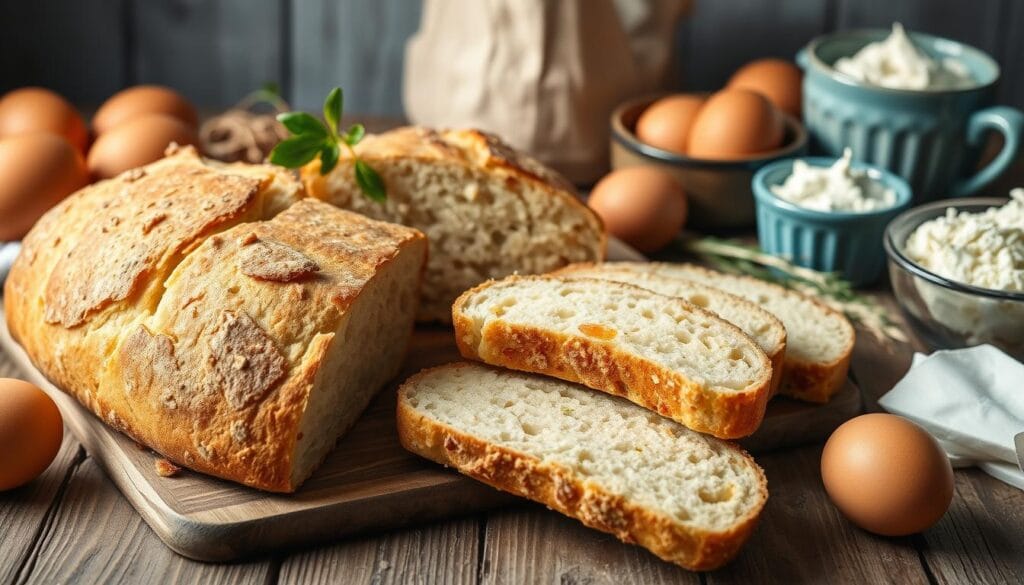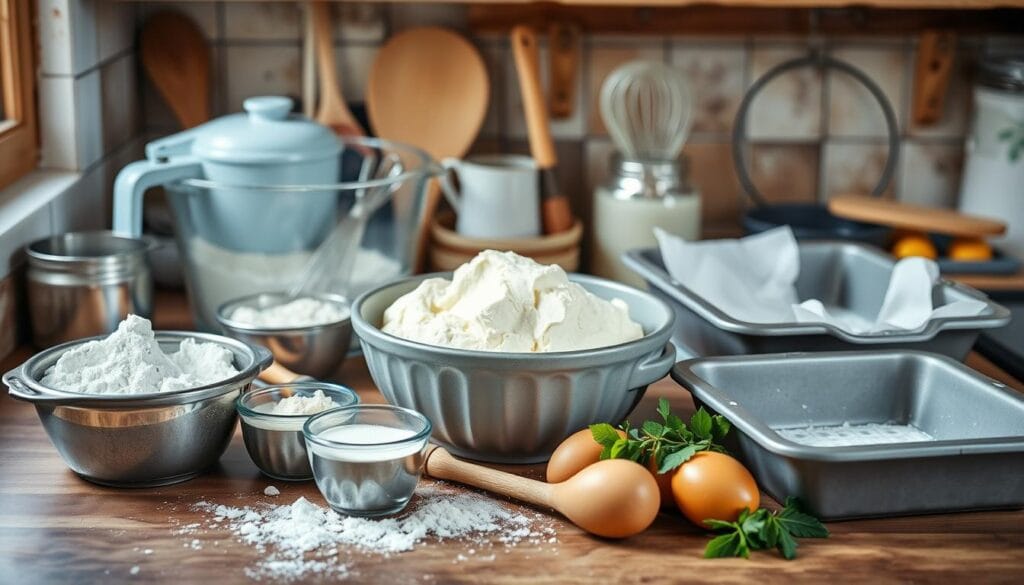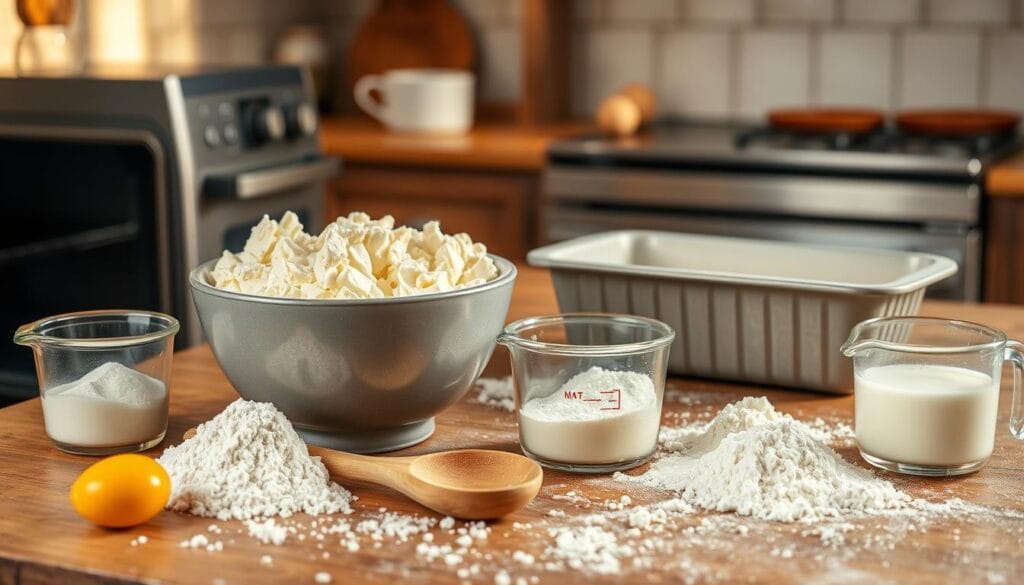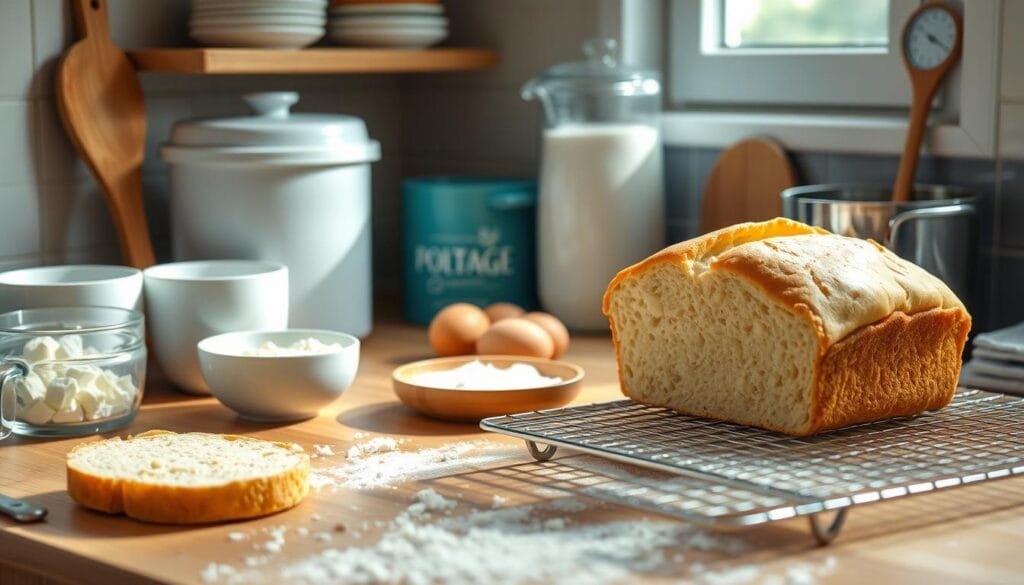Imagine the warm, inviting aroma of freshly baked bread filling your kitchen. It’s a scent that makes any day feel special. Cottage Cheese Bread is more than just a recipe; it’s a journey of flavors and textures.
Every home baker wants to make the perfect bread. This Bread with Cottage Cheese recipe makes it easy. The secret? Creamy cottage cheese adds moisture, protein, and richness.
This bread recipe is perfect for both seasoned bakers and kitchen newbies. It promises delicious results that will wow your loved ones. The beauty of Cottage Cheese Bread is its simplicity. It uses few ingredients and has a big flavor.
Get ready for a baking adventure that will change your view on homemade bread. Each slice is a story of comfort, creativity, and passion. Let’s explore the world of Cottage Cheese Bread and enjoy baking from scratch.
Table of Contents
What is Cottage Cheese Bread?
Cottage cheese bread is a tasty twist on regular bread. It adds moisture and nutrition to your kitchen. This bread mixes cottage cheese’s creamy texture with bread-making skills for a delicious and healthy treat.
Bread lovers find cottage cheese is more than just a spread. It’s a key ingredient that changes the game in baking. It turns simple recipes into amazing dishes.
A Brief History of Cottage Cheese in Baking
Home cooks first used cottage cheese in bread to make it moist and protein-rich. Bakers in Europe and America started adding it to bread long ago. They experimented with different ways to use it.
- 1930s: Early experimental bakers began exploring dairy additions in bread
- 1950s: Cottage cheese became more widely available in home kitchens
- 1970s: Cookbooks started featuring Bread with Cottage Cheese recipes
Why Choose Cottage Cheese for Bread?
Choosing cottage cheese for your bread has many benefits. It makes the bread softer and more tender. It also makes your bread healthier.
“Cottage cheese transforms ordinary bread into a protein-packed, moisture-rich delicacy.” – Culinary Experts
By adding cottage cheese to your bread, you’re making a nutritious treat. It’s perfect for those who care about taste and health.
Benefits of Using Cottage Cheese in Bread
Adding cottage cheese to your bread recipe is exciting. It brings many benefits, making your bread healthier and tastier. It’s a great choice for those who want to bake something nutritious and delicious.

Cottage cheese has unique qualities that make baking better. Let’s look at the main advantages of using it in your bread.
High Protein Content
Cottage cheese boosts your bread’s nutrition. It adds a lot of protein, making your loaf more satisfying and nutritious. Protein helps build muscles and gives you energy all day.
- Increases protein content by up to 15%
- Supports muscle recovery
- Enhances overall nutritional profile
Moisture Retention
Getting the right texture in bread can be hard. Cottage cheese keeps your bread moist and soft for days. It’s a natural way to keep your bread fresh.
| Ingredient | Moisture Retention | Texture Impact |
|---|---|---|
| Cottage Cheese | High | Soft, Tender |
| Regular Milk | Medium | Standard |
| Water | Low | Dry |
Flavor Enhancement
Cottage cheese also adds a creamy flavor to your bread. Its mild tanginess works well with both sweet and savory flavors. This makes your bread more complex and interesting.
“Cottage cheese transforms ordinary bread into an extraordinary culinary experience.” – Professional Baker
Using cottage cheese in your bread is more than just baking. It’s about creating a nutritious, moist, and flavorful masterpiece. Your family and friends will love it.
Key Ingredients for Bread with Cottage Cheese
Making the perfect savory bread starts with picking the right ingredients. Knowing the key parts can make your cottage cheese bread stand out.
Exploring Cottage Cheese Varieties
Not all cottage cheese is the same. The type you choose affects your bread’s texture and taste.
- Low-fat cottage cheese: Lighter, less creamy texture
- Whole milk cottage cheese: Richer, more moisture
- Small curd cottage cheese: Smoother bread consistency
- Large curd cottage cheese: Adds interesting texture
Selecting the Perfect Flour
Choosing the right flour is key in bread baking. Different flours can change your bread’s character.
| Flour Type | Protein Content | Best For |
|---|---|---|
| All-Purpose Flour | 10-12% | Versatile, balanced texture |
| Bread Flour | 12-14% | Stronger gluten, chewier bread |
| Whole Wheat Flour | 13-14% | Nutty flavor, denser texture |
Creative Add-Ins and Variations
Make your savory bread even better with these mix-ins:
- Herbs: Rosemary, thyme, or basil
- Cheese: Parmesan, cheddar
- Seeds: Sunflower, pumpkin
- Spices: Garlic powder, black pepper
“The secret to remarkable bread is not just in the recipe, but in the passion you bring to bread baking.” – Artisan Baker
Pro tip: Always drain excess liquid from cottage cheese to prevent a soggy loaf.
Essential Tools for Baking Bread with Cottage Cheese
Homemade bread making needs the right tools. Before starting, gather the proper equipment. This makes making Bread with Cottage Cheese smooth and fun. You’ll need precise measuring tools and special baking gear.

Choosing the right kitchen equipment is key. Professional bakers say quality tools are essential for tasty homemade bread.
Mixing Bowls and Measuring Tools
Accurate measurements are key in bread making. You should get:
- Stainless steel mixing bowls in various sizes
- Precise measuring cups and spoons
- Digital kitchen scale for exact ingredient weights
- Liquid measuring cups with clear markings
Baking Pans and Utensils
Choose the right baking equipment for perfect cottage cheese bread:
| Baking Pan Type | Best For | Recommended Material |
|---|---|---|
| Loaf Pan | Traditional bread shape | Heavy-gauge aluminum |
| Dutch Oven | Artisan-style bread | Cast iron |
| Baking Stone | Crispy crust | Ceramic |
Kitchen Appliances to Consider
While not necessary, these appliances can improve your bread making:
- Stand mixer with dough hook
- Bread proofing basket
- Instant-read kitchen thermometer
- Dough scraper
“The right tools can turn good bread into great bread.” – Professional Baker’s Wisdom
Pro tip: Invest in quality tools that will last through many bread making adventures. Your cottage cheese bread will thank you!
Step-by-Step Guide to Making Bread with Cottage Cheese
Making Bread with Cottage Cheese at home can be a game-changer. This guide will show you how to make a tasty and healthy cottage cheese bread.

Homemade bread making needs patience and care. The key to a great Bread with Cottage Cheese is knowing each step well.
Preparing the Dough
Begin by collecting these key ingredients:
- 2 cups all-purpose flour
- 1 cup cottage cheese
- 1 packet active dry yeast
- 2 tablespoons olive oil
- 1 teaspoon salt
- 1/4 cup warm water
Kneading Techniques
Kneading is vital for gluten development in your bread. Here are some tips:
- Mix dry ingredients in a large bowl
- Create a well in the center
- Add cottage cheese and warm water
- Knead for 8-10 minutes until smooth
“Perfect kneading creates the texture that makes bread truly exceptional.” – Baking Experts
Rising the Dough
Right rising is key for a light, airy bread. Let the dough rise in a warm, draft-free spot for 1-1.5 hours.
| Rising Stage | Time | Expected Result |
|---|---|---|
| First Rise | 1 hour | Doubled in size |
| Second Rise | 30-45 minutes | Puffy and soft |
Learning this easy bread recipe can elevate your home baking. Remember, the more you practice, the better you’ll get!
Baking Tips for Perfect Bread with Cottage Cheese
Mastering bread baking takes precision and practice. Your Bread with Cottage Cheese can go from good to great with the right techniques. Delicious bread comes from understanding baking nuances and paying attention to details.

Creating the perfect loaf involves several key considerations. These can improve your bread baking skills.
Oven Temperature Mastery
Getting the ideal temperature is key for successful bread baking. Preheat your oven to 375°F (190°C) for most cottage cheese bread recipes. This temperature ensures even cooking and a beautiful golden crust.
- Use an oven thermometer to verify accurate temperature
- Place bread in the center rack for consistent heat distribution
- Avoid opening the oven door frequently during baking
Checking Bread Doneness
A digital thermometer is your best friend in checking bread doneness. Look for an internal temperature of 190-200°F (88-93°C) at the bread’s center.
| Temperature Range | Bread Condition |
|---|---|
| Below 185°F | Undercooked, doughy interior |
| 190-200°F | Perfectly baked |
| Above 205°F | Potentially dry and overcooked |
Crafting a Golden Crust
For a stunning, delicious bread exterior, try these techniques:
- Brush the top with egg wash for shine
- Sprinkle with seeds or coarse salt for texture
- Use steam in the first 10 minutes of baking
“The secret to great bread is patience and practice.” – Professional Baker
Pro tip: Let your bread cool completely on a wire rack. This keeps its crisp crust and prevents soggy bottoms.
Storing and Serving Bread with Cottage Cheese
After making your homemade Bread with Cottage Cheese, it’s important to store and serve it right. This will keep its flavor and texture at their best. Learning how to store and serve your bread will make your meals even better.
Best Practices for Storage
To keep your Cottage Cheese Bread fresh, follow these steps:
- Cool the bread completely before storing
- Wrap in plastic wrap or aluminum foil
- Store at room temperature for 2-3 days
- Refrigerate for extended freshness up to 5 days
- Freeze for long-term storage up to 3 months
Reheating Methods
Bring back the warmth and softness of your Bread with Cottage Cheese with these easy methods:
- Oven method: Preheat to 350°F, wrap in foil, heat for 5-10 minutes
- Toaster method: Slice and toast until golden
- Microwave: Heat in 10-second intervals to prevent dryness
Pairing Suggestions for Serving
Your Cottage Cheese Bread goes well with many dishes and spreads. Here are some tasty ideas:
- Spread with herb-infused butter
- Serve alongside soups and stews
- Create gourmet sandwiches
- Enjoy with fresh salads
- Pair with charcuterie boards
“A great bread can transform an ordinary meal into a memorable dining experience.” – Artisan Baker’s Wisdom
Troubleshooting Common Issues
Homemade bread can sometimes present challenges, even for experienced bakers. Understanding common problems in bread making helps you create the perfect loaf every time. Let’s explore some typical issues you might encounter when baking cottage cheese bread and how to resolve them.
Dealing with Dense Bread Challenges
A dense bread can result from several factors in your homemade bread process. Here are the primary reasons and solutions:
- Incorrect Yeast Activation: Ensure your yeast is fresh and properly activated by using warm (not hot) water
- Insufficient Kneading: Knead the dough thoroughly to develop gluten structure
- Overproofing or Underproofing: Follow precise rising time recommendations
Solving Dryness and Crumbliness
Dry or crumbly bread can be frustrating for home bakers. Check these potential causes:
| Issue | Potential Cause | Solution |
|---|---|---|
| Dry Texture | Too Much Flour | Measure flour carefully, use weight measurements |
| Crumbly Consistency | Lack of Moisture | Add extra cottage cheese or milk to increase hydration |
| Uneven Baking | Oven Temperature Variations | Use an oven thermometer for accuracy |
“Bread making is an art that requires patience and practice.” – Professional Baker
Remember that bread making is a skill developed over time. Each batch teaches you something new about creating the perfect homemade bread. Practice, observe, and adjust your techniques to improve your baking results.
Frequently Asked Questions
Baking a delicious cottage cheese recipe can raise several questions for home bakers. We’ve compiled the most common inquiries to help you perfect your bread recipe and navigate potential challenges.
Ingredient Substitution Strategies
Crafting the perfect cottage cheese bread doesn’t mean you’re locked into strict ingredients. Multiple substitutions can work seamlessly in your bread recipe:
- Low-fat cottage cheese can replace full-fat versions
- Greek yogurt works as an excellent cottage cheese alternative
- Lactose-free cottage cheese supports dietary restrictions
Flour Type Adjustments
Different flour types can dramatically change your cottage cheese bread’s texture and flavor. Here’s a comprehensive guide to flour variations:
| Flour Type | Protein Content | Recommended Adjustments |
|---|---|---|
| All-Purpose Flour | 10-12% | Standard recipe works best |
| Whole Wheat Flour | 14% | Add extra liquid, reduce protein content |
| Gluten-Free Flour | 8% | Add xanthan gum, increase binding agents |
“Baking is a science, but bread making is an art.” – Unknown Baker
When experimenting with different flour types in your cottage cheese recipe, remember that each variation requires slight modifications to achieve the perfect loaf. Start with small batches and take notes on your results.
Pro Tips for Successful Substitutions
- Always measure ingredients precisely
- Understand each ingredient’s role in the bread recipe
- Experiment gradually
- Keep a baking journal to track successful modifications
Flexibility is key in creating your ideal cottage cheese bread!
Creative Twists on Cottage Cheese Bread
Make your healthy bread more exciting by trying new versions of cottage cheese bread. This easy recipe can become truly special. Your creativity can bring out amazing flavors that will wow everyone.
Savory Variations to Try
Add bold flavors to your cottage cheese bread for a unique taste. Try mixing in fresh rosemary and black pepper for a fragrant bread. Or, add sharp cheddar cheese and jalapeños for a spicy twist.
Sundried tomatoes and basil give it a Mediterranean flavor. This makes the bread hard to resist.
Sweet Versions Worth Making
If you love sweet treats, cottage cheese bread is perfect. Add cinnamon and apples for a breakfast delight. Or, mix in dark chocolate chips and orange zest for a dessert bread.
Nuts like pecans or walnuts add great texture. They make each slice feel like a gourmet treat.
Remember, finding the right balance is key. Start with small amounts and adjust to taste. Your cottage cheese bread can be a blank canvas for your creativity.
FAQ
Can I use low-fat cottage cheese in this bread recipe?
How long will homemade Cottage Cheese Bread stay fresh?
Can I make this bread gluten-free?
Is Cottage Cheese Bread suitable for people watching their protein intake?
Can I add herbs or other mix-ins to the Cottage Cheese Bread?
What if my dough doesn’t rise properly?
How can I tell when the Cottage Cheese Bread is fully baked?
We Value Your Feedback!
There are no reviews yet. Be the first one to write one.

